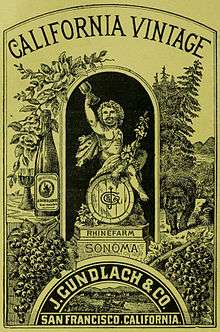Gundlach Bundschu
| Gundlach Bundschu | |
|---|---|
| Location | Sonoma, California, USA |
| Appellation | Sonoma County AVA |
| Founded | 1858 |
| Cases/yr | 40,000 |
| Varietals | Gewurztraminer, Cabernet Sauvignon, Chardonnay |
| Tasting | open to the public |
| Website | www.gunbun.com |
Gundlach Bundschu is California's oldest continuously family-owned winery, and is the second oldest winery after Buena Vista Winery (established a year earlier by Agoston Haraszthy). It is still owned and operated by the founder's heirs and today led by the sixth generation, Jeff Bundschu. The winery's 320-acre (1.3 km2) estate vineyard, named Rhinefarm by Bavarian-born Jacob Gundlach in 1858, is located within the Sonoma Valley AVA of Sonoma County, at the crossroads of the Sonoma Valley, Los Carneros AVA and Napa Valley AVA, along the Mayacamas Mountains.
History

The company was founded by Jacob Gundlach in 1858. Charles Bundschu, from Mannheim, Germany, joined the company in 1868, and became part of the family when he married Jacob Gundlach’s daughter Francisca in 1875. J. Gundlach & Co. grew significantly over the next 30 years, distributing rhine wines from its factory at Second and Bryant in what is now the Soma District in San Francisco, California and its headquarters nearby on Market Street at Second.[1] There was a New York branch as well. After Jacob’s death in 1894, the company was renamed Gundlach Bundschu. By the time of the great earthquake of 1906 the company was a major international wine producer, distributing over 250,000 cases of mostly fortified wine per year.[1]
The earthquake destroyed the winery's production facilities, one million gallons of wine, and even Charles Bundschu's home.[2] The winery never regained its earlier stature as a major producer of bulk wine. Instead the company regrouped and moved operations to its vineyards in Sonoma County. The company suffered another setback during Prohibition, when alcohol was made illegal in the United States. Unable to sell wine, the company let its grapevines die and raised cattle instead under Towle Bundschu, the grandson of the founder. Walter, of the fourth generation of Bundschus, replanted grapes after the repeal of prohibition, but the company did not begin producing wine again until the early 1970s.[1]
Fifth-generation Jim Bundschu developed a plan to restore the family winery in 1969, with the first modern vintage in 1973. Unable to obtain premium prices for Sonoma County grapes at the time despite their high quality (and correspondingly lower yield), he decided that the only way to capitalize on the vineyards' value was to produce his own premium-level wine. Production was initially 70,000 bottles per year but dropped in the late 1990s, as the company focused on the quality of estate-grown Rhinefarm wines.[1] In 1997, the Bundschu family acquired 140 acres (0.57 km2) of land adjacent to the existing historic Rhinefarm Vineyard. Jeff became president of the winery in 2000. Production was also decreased and is today around 40,000 cases per year.
Winery & estate
Approximately 150 acres (0.61 km2) of Rhinefarm estate have been planted over the last 10 years, including 25 acres (100,000 m2) of Pommard 5, Dijon 115, 667 and 777 clone Pinot Noir on the valley floor and 110 acres (0.45 km2) of Bordeaux varieties planted on the rocky slopes of Arrowhead Mountain, part of the Mayacamas. Rhinefarm Vineyard now has 320 acres (1.3 km2) under vine, farmed in more than 50 distinct blocks. Keith Emerson has been the winemaker since 2008.
External links
- Gundlach Bundschu Official Website
- http://www.sonoma.winecountry.com/about/experience/2006/04/gundlachBundschuEarthquakeWalk.html
- http://www.gunbun.com/web/htdocs/our_story/history.html
References
- 1 2 3 4 W. Blake Gray (2006-04-13). "The Great Quake: 1906-2006:A brand renewed". San Francisco Chronicle.
- ↑ "Retracing the 1906 Earthquake:Sonoma Winemaker Commemorates the Events That Devastated the Gundlach Bundschu Winery 100 Years Ago". winecountry.com. April 2006.
Coordinates: 38°16′51″N 122°25′1″W / 38.28083°N 122.41694°W